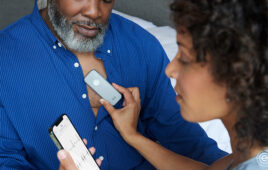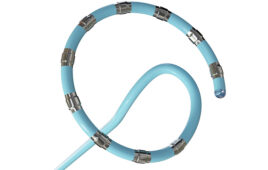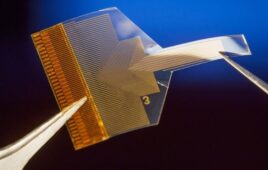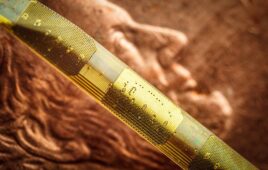
[Image from Tuft University]
Tuft University School of Engineering researchers created a sensor that communicates wirelessly with a mobile device. It transmits information regarding glucose, salt and alcohol intake, which the researchers suggest could help detect and record a variety of nutrients, chemicals and physiological states.
Other wearable devices that monitor dietary intake have limitations like having to use a mouth guard, bulky wiring and have to replace frequently because of quickly degrading sensors. The researchers at Tuft developed a sensor that is tiny enough to bond to the irregular surface of the tooth, eliminating the need for traditional wearable devices.
The flexible sensor is 2-by-2 mm in size and transmits its data wirelessly in response to incoming radiofrequency signals.
The sensor also has three sandwiched layers that include a central “bioresponsive” layer that absorbs the nutrients or chemicals and two square-shaped gold rings on the outer layers. The layers serve as an antenna that collects and transmits radiofrequency waves. As the waves bit the sensor, part of the wave is cancelled while the rest gets transmitted back.
If a central layer comes into contact with salt or ethanol, the electrical properties of the sensor will change and the sensor will absorb and transmit a different spectrum of radiofrequency waves. Nutrients and anlytes can then be detected and measured.
“In theory, we can modify the bioresponsive layer in these sensors to target other chemicals – we are really limited only by our creativity,” Fiorenzo Omenetto, author on the study, said in a press release. “We have extended common RFID [radiofrequency ID] technology to a sensor package that can dynamically read and transmit information on its environment, whether it is affixed to a tooth, to skin, or any other surface.”
The research was published in the journal Advanced Materials and was supported by U.S. Army Natick Soldier Research, Development and Engineering Center, the National Institutes of Health National Institute of Biomedical Imaging and Bioengineering and the Office of Naval Research.




